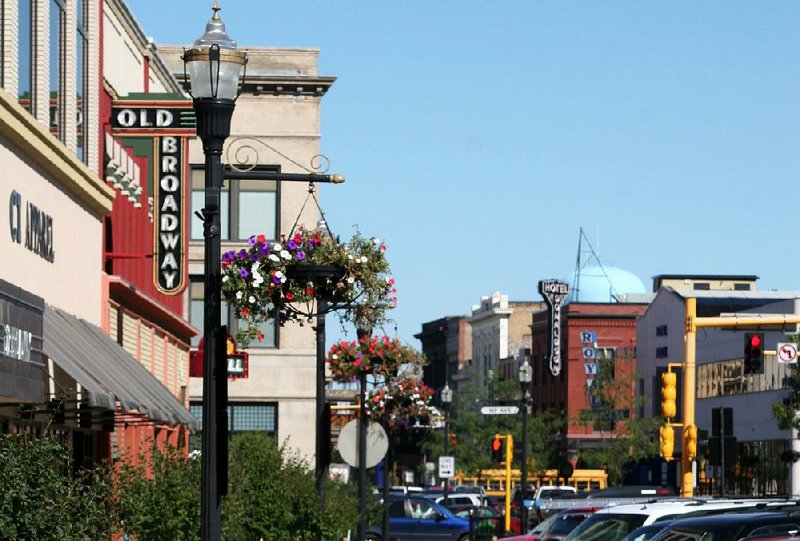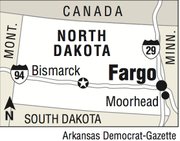FARGO, N.D. -- North Dakota was literally the last state in the union that I had reason to see. I had visited all 49 others. But the chance to cross off the 50th state before a milestone birthday had my always-game little sister and me pulling into Fargo's squat brick downtown on a spring day.
We weren't sure what lay ahead. We'd deliberately avoided watching Fargo, the Coen brothers' 1996 black comedy that remains many Americans' only cultural touch point for North Dakota (and its flat accent). Now, though, avoiding that pop-culture reference has gotten even harder. The new FX show Fargo, starring Billy Bob Thornton and based on the movie, premiered in April. Its last episode was Tuesday. National curiosity about what's there has picked up along with it.
The blank we'd drawn about North Dakota was replaced with sleek prairie art and design as we checked into the Hotel Donaldson. For months, I'd been asking anyone I knew from the upper Midwest
what I should see in Fargo. The recommendations that followed were weak, until a friend of a friend, North Dakota State University architecture alumnus Tim Bungert, swore that the Hotel Donaldson was world-class. "There are some awesome changes happening in downtown Fargo," he said, "and the HoDo is right at the heart of it all."
We owe him hugely. The HoDo, as locals call it, set the tone for our stay. To our surprise and soon-to-follow delight, it primed us for a weekend of sophisticated design and art in this city of 100,000.
With the HoDo (and its similarly dubbed restaurant), local entrepreneur Karen Stoker made a trend-setting $7 million investment in Fargo's downtown. That was 15 years ago, back when the area was blighted by panhandlers and hourly rate motels. Undaunted, Stoker started carving a restored Odd Fellows Lodge into her boutique hotel. Today the bedding is luxurious, the speakers are Bose, the good-night truffles are house-made, and the bathroom tiles are heated.
What's more, Stoker had each of the hotel's 17 rooms designed by a Great Plains artist. Minnesota-based Mike Marth had decorated our Room 13 with nails and other found objects in rusty earth tones. We'd be seeing more of his work later in galleries and museums.
The HoDo's showstopper is its "sky prairie," a rooftop bar framed by trellises and tall grass, with the most scenic hot tub in town. Not only does the hot tub work year-round, but as we learned later that night, the staff will also keep it open late on request.
In the meantime, feeling less than fresh after the three-hour drive from Minneapolis, we wanted a drink. The sun eased away behind the hotel's stylish neon sign and downtown Fargo beyond. The setup was cosmopolitan. So were the cocktails, featuring ingredients such as rhubarb vodka, fresh-squeezed orange juice and ginger simple syrup.
Naturally, we toasted to North Dakota and the number 50. Our waitress seemed slightly confused yet unsurprised when we explained that it was my final state to visit. "A lot of people say that," she said. "I don't know why."
North Dakota's undeserved underrating becomes even clearer at the nearby Plains Art Museum. The 56,000-square-foot building used to be a warehouse for the tractor company International Harvester. Now it's flooded with light across clean white walls and wooden beams. The spacey North Dakota Mural by major pop artist James Rosenquist, a Grand Forks native, is set off by a three-story atrium. The effect is striking enough that we saw this former machine shed being set up for a wedding reception that night.
In the museum's collection, Andy Warhol's Four Jackies sits between Kiva Rest by American Indian Luiseno Fritz Scholder and New Age Fancy Dancer II by Star Wallowing Bull, a Chippewa. Both regional works are just as bright and riotous as Warhol's. The juxtapositions of prairie and world-renowned art feel inspired.
Blocks away, downtown shops offer everything from neon wedge sneakers at boutique Lot 2029 to 19th-century firearms at Frontier Americana of Fargo. An arts highlight is the gallery Ecce. All poured concrete, exposed brick and stark walls, it has been called more Manhattan than Midwest. Gallery founder Mark Weiler invites yoga classes to be held there, too. As in the Hotel Donaldson, the art in Weiler's gallery becomes something to live around.
Over at the Hjemkomst Center, beautiful craft testifies to the grit of North Dakota's Scandinavian descendants. The cultural center is technically in Minnesota, just across the Red River in next-door Moorhead. But it's still within a half-mile walk of the HoDo, a walk that takes visitors through a riverside park en route. The trails run past such only-on-the-Great-Plains sights as prairie grass meadows and backyard teepees.
The story behind the Hjemkomst Center is storybook. In 1971, guidance counselor Robert Asp decided to replicate a Viking ship to honor his Norwegian heritage but he developed leukemia soon after. The town pitched in over six years to help build his dream. Asp finally got to sail his ship on Lake Superior before dying four months later.
After their father's death, Asp's children and a few professional Norwegian crew members sailed the ship 6,000 miles. They floated through the Great Lakes to New York and then on to Norway. Now the 76-foot-long, 63-foot-high Hjemkomst is on permanent indoor display. Its pointed Viking ends look ferocious. Yet the precariousness of a small wooden ship weathering the swells and storms of the Atlantic for two months is obvious, too.
In back of the Hjemkomst Center is an equally ambitious Norwegian craftsman's project, the cedar-and-pine Hopperstad Stave Church. Guy Paulson, a North Dakota State biochemistry professor, spent five years carving this full-scale replica of a wooden church that dates from 1140 back in Vik, Norway. Each of Paulson's 25,000 impressive hand-carved wooden shingles had to be beveled and pointed at the ends.
Still, the shingles pale in comparison to the spectacular interior, where Paulson carved Norway pine in the Urnes style, complex Viking patterns of entwined dragons, plants and animals. The message of the Hjemkomst and the Hopperstad Stave Church could not be clearer: Few people on Earth could be more determined than these crazy Scandinavians.
All this art and design necessitate refueling with excellent food. Artsy types such as Weiler frequent Mezzaluna, a local classic that serves high-end cuisine among 6-foot silver clamshell banquettes, an original pressed-tin ceiling and candlelight in a restored 1917 office building.
Executive chef Eric Watson's local bison meatloaf is rich. Even more perfect, though, are his garlic-and-asiago tater tots. Comforting and Midwestern, their fried-potato sizzle takes me back to childhood, to my elementary school cafeteria. But our lunch ladies never infused theirs with fine aged cheese or irresistible garlic. Somehow, these tater tots are just like Fargo itself: still humble, but sophisticated, too.
Travel on 06/22/2014


